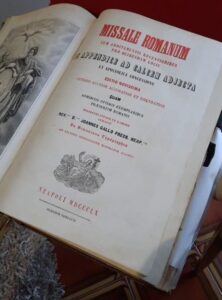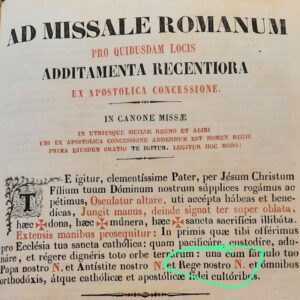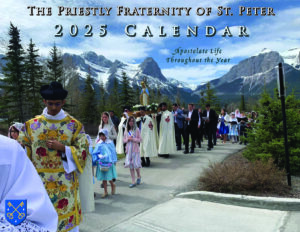The Missions of the Holy Ghost
by Fr. William Rock, FSSP

On the Feast of Pentecost, the Church celebrates the descent of the Holy Ghost on the Apostles and Disciples following the Lord’s Ascension. While this is an extremely important moment in the Church’s history, it ought to be noted that this is not the first visible mission of the Holy Ghost, but the fourth.
To begin with, a visible mission (Latin: missio, “sending”) of a Divine Person is a sensible manifestation which expresses the supremely important spiritual realities being brought about outside of the Divinity by a Divine Person Who was sent by another Divine Person (or Persons) in a manner which is able to be known by man, whose knowledge begins with his senses. With respect to the Holy Ghost, these missions were “directed to Christ, to the apostles, and to some of the early saints on whom the Church was in a way founded” (S.T. I, q. 43, a. 7, ad 6).
In the first place there was the visible mission of the Holy Ghost in the form of a dove at the Lord’s baptism (Matt 3:13-17; Mark 1:9-11; Luke 3:21-22). As St. Thomas explains in his theological Summa: the form of a dove, “a fruitful animal…show[s] forth in Christ the authority of the giver of grace by spiritual regeneration; hence the Father’s voice spoke, This is My beloved Son (Matt 3:17), that others might be regenerated to the likeness of the only Begotten.”
The second visible mission of the Holy Ghost was in the form of the bright cloud at the Lord’s transfiguration (Matt 17:1-13; Mark 9:1-7; Luke 9:28-36). According to St. Thomas, this manifestation in the form of a bright cloud represented “the exuberance of doctrine; and hence it was said, Hear ye Him (Matt 17:5).”
On the evening of the Resurrection, the Risen Lord breathed on the Apostles and said to them “Receive ye the Holy Ghost” (John 20:22). This is the third visible mission. The fourth visible mission, as was mentioned, occurred at Pentecost and was manifested by the sound of a mighty wind and by tongues of fire (Acts 2:2-3). St. Thomas explains these missions as follows: “To the apostles the mission was directed in the form of breathing to show forth the power of their ministry in the dispensation of the sacraments; and hence it was said, Whose sins you shall forgive, they are forgiven (John 20:23): and again under the sign of fiery tongues to show forth the office of teaching; whence it is said that, they began to speak with diverse tongues (Acts 2:4).”

It should be noted that the visible mission of the Holy Ghost at Pentecost is unique in that it is the only time the Holy Ghost had a visible mission without a manifestation of either of the other two Divine Persons. At the Baptism and Transfiguration, all three Divine Persons were manifested. On the day of the Resurrection, the Son was also manifested. The visible manifestation of the Holy Ghost alone at Pentecost indicates the beginning of a new era, the era of the Church, which the Holy Ghost guides as history unfolds.
In the last two visible missions, the Holy Ghost manifests that what had been indicated previously with regards to the Son has been entrusted to the Apostles. There is a connection between Christ’s Baptism and the Breathing of the Holy Ghost in that the former shows Christ as the “giver of grace” and the pattern of the regenerated Faithful, while the latter shows the entrusting to the Apostles of the Sacraments which are the primary means by which Christ gives grace and conforms the Faithful to Himself. There is also a connection between the Transfiguration and Pentecost in that the former expresses that Christ is teaching a divine doctrine, and the latter expresses that the Apostles were entrusted with a teaching office to preach the same doctrine. These connections show that the Apostles, and, by extension, their successors, were empowered by the Holy Ghost to continue the work of Christ, teaching and sanctifying in the world with divine power. But this also means that the second two visible missions of the Holy Ghost cannot be fully understood without referencing the first two.
Fr. William Rock, FSSP was ordained in the fall of 2019 and is currently assigned to St. Stanislaus Parish in Nashua, NH.
In support of the causes of Blessed Maria Cristina, Queen, and Servant of God Francesco II, King
June 8, 2025
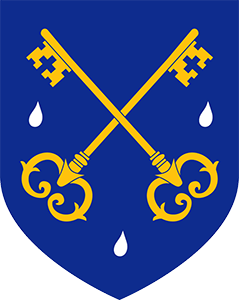
The Twelve
by Fr. William Rock, FSSP
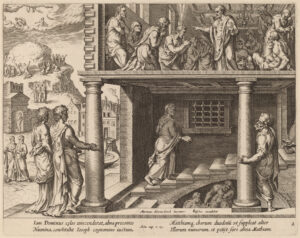
During the days between Our Lord’s Ascension and the coming of the Holy Ghost on Pentecost, St. Peter, as the head of the Church, oversaw the election of St. Matthias to replace Judas. This event is recorded in the Acts of the Apostles (1:15-16, 20-26):
In those days Peter rising up in the midst of the brethren, said (now the number of persons together was about an hundred and twenty): Men, brethren, the scripture must needs be fulfilled, which the Holy Ghost spoke before by the mouth of David concerning Judas, who was the leader of them that apprehended Jesus…For it is written in the book of Psalms: Let their habitation become desolate, and let there be none to dwell therein. And his bishopric let another take. Wherefore of these men who have companied with us, all the time that the Lord Jesus came in and went out among us, beginning from the baptism of John, until the day wherein He was taken up from us, one of these must be made a witness with us of His resurrection. And they appointed two, Joseph, called Barsabas, who was surnamed Justus, and Matthias. And praying, they said: Thou, Lord, Who knowest the heart of all men, shew whether of these two Thou hast chosen, to take the place of this ministry and apostleship, from which Judas hath by transgression fallen, that he might go to his own place. And they gave them lot, and the lot fell upon Matthias, and he was numbered with the eleven apostles.
After reading this account, the question can be raised, why was it that the Apostles needed to be restored to 12? There are several answers which can be given.
The most immediate answer is because the Apostles were to be the foundation of the New Israel just as the 12 sons of Jacob were the foundation of the Old Israel. The Sons of Jacob, the 12 Patriarchs, were the fathers of all the Israelites, and the Apostles were to be the spiritual fathers of all Christians. Therefore, it was fitting that the number of Apostles be 12 when the Church, the New Israel, manifested herself to the world.
There being 12 Apostles also shows a conformity between the Old Law and the New Law.1 Some early heretics tried to set the Old Law against the New, even saying the God of the Old Testament and the God of the New Testament were two different Gods. But having the foundation of both Testaments be 12 – 12 Sons of Jacob and 12 Apostles – shows their conformity.
In considering these two reasons, it is important to keep in mind that the 12 Patriarchs were a type, a foreshadowing, of the Apostles. God had in mind the 12 Apostles when He established the 12 Patriarchs, not that He made there be 12 Apostles because there were, by chance, 12 Patriarchs.

But why did God choose that there should be 12, not more nor fewer?
In the first place, it should be understood that 12 is considered a complete count. We are accustomed to counting on our fingers and thumbs to 10 with each digit being used for one count. Once 10 is reached, all digits have been used, and thus 10 is considered a complete count. In other cultures, such as the Babylonians, the thumb on one hand was used to count the portions of the fingers on the same hand while the digits on the other hand were used to keep track of how many times all of the portions were counted. Each finger had three portions: hand to first knuckle, first knuckle to second knuckle, and second knuckle to end. One pass through all of the portions gave a count of 12, thus making 12, and then 60 (=12*5), a complete count.2
Another explanation is that the Apostles were sent to preach the Three Persons of the Holy Trinity, represented by the number 3, to the four corners of the world, which can thus be represented by the number 4. 12, then, as it is the product of 3 and 4, represents the preaching of the Holy Trinity to the whole world. This fulfills the Lord’s Command heard in the Gospel of the Ascension: “Go ye into the whole world and preach the gospel to every creature” (Mark 16:15). That this was fulfilled is expressed by St. Paul in his letter to the Romans (10:18), where he quotes from the Book of Psalms. A fuller quotation from the Psalm reads thus: “there are no speeches nor languages, where their voices are not heard. Their sound hath gone forth into all the earth: and their words unto the ends of the world” (18:4-5).

12 also signifies a high perfection because it is 6 doubled. 6 is, according to St. Thomas Aquinas,3 a perfect number as it is the sum of its parts. What parts? Its Triangular parts. 6 is the third of what are called by modern mathematicians “Triangular Numbers,” which were previously encountered in an article on the Holy Rosary. These numbers can be visualized by using beads laid out to form a growing triangle. The number of beads which form a complete row of the growing triangle, thus forming a complete triangle, and which number is also equal to the sum of the count of rows (their “Triangular parts”), are Triangular Numbers (see accompanying image). These Triangular Numbers have a certain perfection, according to St. Thomas, exactly because they can be produced by summing their parts, that is, by summing the count of rows of their bead triangles.
Returning to the number 6, it can be seen that it is a Triangular Number as 6 beads can be used to form a full triangle. Its Triangular parts are found from the count of the number of rows of beads in a six-bead triangle. As a six-bead triangle has three rows, 1, 2, and 3 are found to be the Triangular parts of 6 with 6 itself being the sum of these parts (6=1+2+3). As this is the case, 6 is, according to St. Thomas, a perfect number. 6 is also formed by the product of its Triangular parts, 1*2*3=6. 6, then, is perfect in two ways as it can be reached by the addition and the product of its Triangular parts. Since 12 is twice 6 (6*2=12), 12 is double perfection of the perfection of 6. Now, the foundation of Christ’s Church must have a certain perfection, for, as it says in the Book of Deuteronomy (32:4), “the works of God are perfect.” Therefore, it is fitting that the number of the Apostles expresses this perfection as they are the foundation of the Church, for, as St. Paul wrote to the Ephesians (Eph2:20), the Church is “built upon the foundation of the apostles and prophets, Jesus Christ himself being the chief corner stone.”
It was fitting, then, that the number of the Apostles be returned to 12 before the public manifestation of the Church on Pentecost in order to show that they were the foundation of the New Israel and that the New Law is in continuity with the Old Law by the Apostles fulfilling their type of the 12 Patriarchs, the Sons of Jacob, to express that the Apostles were a full count, that they were tasked with the preaching of the Holy Trinity to the whole world, and to communicate the high perfection of the Church. May these thoughts accompany us during these days between the feast of the Ascension and Pentecost and help to make them fruitful.
Fr. William Rock, FSSP was ordained in the fall of 2019 and is currently assigned to St. Stanislaus Parish in Nashua, NH.
In support of the causes of Blessed Maria Cristina, Queen, and Servant of God Francesco II, King
- St. Thomas’ Commentary on Matthew, 10.1 (810).
- How 10 Fingers Became 12 Hours | EarthDate.
- St. Thomas’ Commentary on Matthew, 10.1 (810).
June 3, 2025

Bethany
by Fr. William Rock, FSSP

St. Luke gives us two accounts of the Ascension, one at the beginning of Acts (1:1-11), which is read on the Feast of the Ascension as the Epistle, and another at the end of his Gospel (24:36-53). In the shorter version given in his Gospel, St. Luke relates something which is not recorded in the longer version given in Acts or in St. Mark’s account (16:14-20), which is read as the Gospel on the Ascension. In his Gospel account, St. Luke states that Our Lord ascended from or near the town of Bethany (Bethania) on Mount Olivet – “And He led them out as far as Bethania: and lifting up His hands, He blessed them. And it came to pass, whilst He blessed them, He departed from them and was carried up to heaven” (Luke 24:50-51).
As stated, Bethany was located to the east of Jerusalem, on Mount Olivet. It was here that Our Lord received hospitality in the house of Martha and Mary during his public ministry (see, for example, John 11:1), especially during the week of His Passion, as He would retire to Bethany in the evenings after teaching in the holy city (see Mark 11).
At least as far back as the ecclesiastical writer Origen, who died around the year A.D. 253, “Bethany” was interpreted to mean “House of Obedience.”1 “Beth” means “house” and is found in other placenames, such as in “Bethlehem,” “House of Bread.” While this meaning might not be accepted by modern scholars,2 the Christian tradition of understanding Bethany to mean “House of Obedience” is very ancient and much fruit has been gathered from reflecting on this.
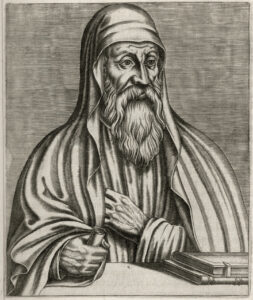
To begin with, Our Lord came into this world to undo disobedience. In the first place, this is the disobedience of Adam who, in eating the forbidden fruit of the Tree of the Knowledge of Good and Evil, brought sin to the human race. As St. Paul wrote to the Romans: “by the disobedience of one man, many were made sinners” (Rom 5:19). But Our Lord also came due to the disobedience found in the sins of all, for, as St. Augustine wrote, sin is a “thought, word, or deed contrary to the eternal law,”3 and thus all sin can be seen as disobedience to God’s Law. Our Lord counteracted all this disobedience through obedience to His Father and it is by this obedience that men are able to be justified before God – “by the obedience of one, many shall be made just” as St. Paul continues.
It was fitting then, that Our Lord should begin this undoing of disobedience at Bethany, the House of Obedience.4 For not only did Our Lord reside in Bethany during Holy Week, but it was the anointing at Bethany before His Triumphal entry which marks the start of His Passion as witnessed by the Matthean and Marcian Passion accounts as they were read in Holy Week before the changes made under Pope Pius XII in the 1950s.
Not only does Christ’s obedience justify sinners, but it also brought Him glory, for, as St. Paul wrote to the Philippians, Christ “humbled himself, becoming obedient unto death, even to the death of the cross. For which cause, God also hath exalted Him and hath given Him a name which is above all names” (Php 2:8-9). Our Lord was exalted in His Resurrection, Ascension, and His being seated at the right hand of the Father. It was fitting, then, that He should ascend from the House of Obedience for it was His obedience which led to His exaltation.

Other interpreters, such as the Venerable Bede (d. A.D. 735), also see in Bethany, the House of Obedience, a type or pattern for the Church5 for the Church is called to be obedient to the Lord’s command to the Apostles: “Go ye into the whole world and preach the gospel to every creature….teach ye all nations: baptizing them in the name of the Father and of the Son and of the Holy Ghost. Teaching them to observe all things whatsoever I have commanded you” (Mark 16:15; Matt 28:19-20). The Church is most herself when she is obedient to Our Lord’s commission, working for the greater external glory of God and the salvation of souls.
The faithful, if they wish to follow Our Lord to Heaven, must be in Bethany, in the House of Obedience, that is, in the Church. They are also called to be in “obedience to the faith” (Rom 1:5) and be among those who have “obeyed from the heart unto that form of doctrine into which [they] have been delivered” (Rom 6:17). Holding articles of the Faith to be true is not the same as accepting things as true which can be experienced by the senses or determined philosophically. The truths of the Faith are mysteries; that is, they are above but not contrary to unaided natural reason. To accept these mysteries of the Faith as true – things such as the Holy Trinity, the Incarnation, the Passion, Death, Resurrection, and Ascension of the Son, the Church, and the Sacraments – an act of the will is needed because the truth of these mysteries is not readily apparent to the intellect. This act of the will in believing is also a form of obedience for, as St. Thomas wrote in his Commentary on Romans (1:5), “obedience finds its scope in things we can do voluntarily; in matters of faith, since they are above reason, we consent voluntarily. For no one believes unless he wills to, as Augustine says.” Thus, as Origen wrote, “every man who is obedient to the word of God is Bethany, and Christ abides in him.”6
Fr. William Rock, FSSP was ordained in the fall of 2019 and is currently assigned to St. Stanislaus Parish in Nashua, NH.
In support of the causes of Blessed Maria Cristina, Queen, and Servant of God Francesco II, King
- As quoted in St. Thomas’ Catena Aurea, Luke, 19.3.
- See, for example, Old Catholic Encyclopedia, s.v. “Bethany.”
- Reply to Faustus XXII.27.
- See the Venerable Bede as quoted in St. Thomas’ Catena Aurea, Luke 24.7
- Ibid.
- As quoted in St. Thomas’ Catena Aurae, Matthew 21.3.
May 29, 2025

Priestly Ordination Livestream: Wed. May 28th @ 10 AM CST
Join us on Wednesday, May 28th as we celebrate the ordination of five Our Lady of Guadalupe seminarians to the sacred priesthood!
The ceremony begins at 10 AM Central time and will be livestreamed here:
https://www.youtube.com/@olgsbasketball1870/streams
May God bless and keep the ordinandi!
May 27, 2025

Election of Pope Leo XIV
Fribourg, May 9, 2025
“Pax Vobis”
Deeply heartened by these first words of Leo XIV in echoing the Good Shepherd in these days after the Resurrection, we ardently join the Holy Father in his intentions for peace within the world and within the Church. We assure him of our fervent prayers by invoking in particular our own Patron, St. Peter, Prince of the Apostles.
Tu es Petrus, et super hanc petram ædificabo ecclesiam meam
Oremus pro pontifice nostro, Leone, Dominus conservet eum, et vivificet eum, et beatum faciat eum in terra, et non tradat eum in animam inimicorum eius.
May 12, 2025

Statement on the Death of Pope Francis
Fribourg, April 21, 2025
Having learned of the passing from this world of Pope Francis today, April 21, 2025, the Priestly Fraternity of St. Peter is ardently praying for the repose of his soul. As the Servant of the Servants of God, he often humbly asked to be remembered in the prayers of those who met him. We are indebted to him for being a Father toward our Fraternity, in particular by his decree of February 11, 2022, clearly reaffirming the practice and charism that the Fraternity has had from its foundation.
Requiem Masses with the absolution will be celebrated in the apostolates entrusted to the Fraternity in order to “pray to God that through the Sacrifice offered for the soul of his servant, he may be admitted into the celestial kingdom in the company of all the saints.” (Requiem Mass for a Sovereign Pontiff)
Source : www.fssp.org
April 21, 2025

Praying for the Dead during Lent
by Fr. William Rock, FSSP
In February of A.D. 2025, the New Liturgical Movement blog published an article in four parts entitled “The Antiquity and Universality of Fore-Lent” by Mr. Henri de Villiers (part 1, part 2, part 3, part 4). In the first and fourth parts, Mr. de Villiers explains:
The reminder of human fragility, meditation on the last things, and consequently, prayer for the dead, are recurrent elements of this liturgical season.
Just as the liturgy of Fore-Lent reminds us of our mortal condition fallen though [sic] sin, this period has also become in many liturgical traditions a privileged time to pray for the dead.
In the Armenian Rite, the Thursday of Quinquagesima (the last before the beginning of Lent) is dedicated to the commemoration of all the faithful departed. The same holds true for the Saturday before the Sunday of the Last Judgment in the Byzantine Rite; this is attested in the Typikon of the Great Church in the 9th or 10th century, the most important document describing the arrangement of services at Hagia Sophia. The Assyro-Chaldean rite has a similar observance on the Friday of the second week before Lent.
Among the Maronites, the three Sundays of Fore-Lent are dedicated to the commemoration of the dead, the first to deceased priests, the second to the “just and righteous”, the last to all the faithful departed. The arrangement of the season among the Syrian Jacobites is undoubtedly the more primitive: the fast of the Ninevites from Monday to Friday of Septuagesima week, the Sunday of prayer for deceased priests on Sexagesima, and for all the faithful departed on Quinquagesima.
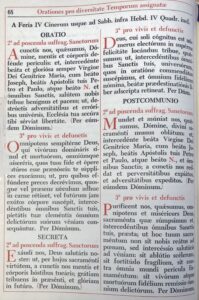
So far as I am aware, it was never the practice of the Roman church to pray for the dead during the season of Septuagesima (the Roman Fore-Lent) and, supportingly, Mr. de Villiers does not give a Roman example of such a practice in his exposition. There is, however, the tradition of praying for the dead (and living), motivated, in all likelihood, by the same above-mentioned considerations, in the seasonal orations for the first four weeks of Lent.1 Seasonal orations are two sets of three prayers assigned for specific liturgical seasons which are to be added after the prayers of the Mass on days observed as semi-doubles or simples.2 The inclusion of additional oration sets beyond that of the Mass being celebrated “became a feature of the Carolingian liturgy,” that is, the liturgy as celebrated during the Carolingian era within the Carolingian Empire (A.D. 800–887), and “reached Rome about the 12th century.”3 A systemization of assigning prayer sets to the different liturgical seasons is attested to by the Tridentine Missal promulgated by Pope Pius V. These seasonal orations remained in the Roman Missal until the changes made under Pope Pius XII in the 1950s. After these changes, these sets of prayers are still present in the Missal and can be used ad libitum by the celebrant according to the rubrics, but seasonal orations as such are no longer assigned. Relative to the discussion here, it is the second set of seasonal orations for the season of Lent that contains the previously mentioned prayers for the living and dead (pro vivis et defunctis). It should be noted that these prayers for the living and dead are not used as seasonal orations at any other time of the year.
The translations of these prayers are as follows:
Collect (opening prayer): O almighty and eternal God, Who hast dominion over the living and the dead, and art merciful to all Whom Thou knowest will be Thine by faith and good works: we humbly beseech Thee, that they, for whom we have proposed to offer our prayers, whether this world still retains them in the flesh, or the next world hath already received them divested of their bodies, may, by the clemency of Thine own goodness, and the intercession of Thy Saints, obtain pardon and full remission of their sins. Through, etc.
Secret (prayer over the oblations): O God, to Whom alone is known the number of Thine elect to be placed in eternal bliss: grant, we beseech Thee, by the intercession of all Thy Saints, that the book of predestination may contain the names of all those for whom we have undertaken to pray, as well as those of all the faithful. Through, etc.
Postcommunion (closing prayer): May the mysteries we have received, purify us, we beseech Thee, O almighty and merciful God; and grant by the intercession of all Thy Saints, that this Thy Sacrament may not increase our guilt to punishment, but be a means of obtaining pardon in order to salvation. May it wash away sin, strengthen our frailty, secure us against the dangers of the world; and procure forgiveness for all the faithful, both living and dead. Through, etc.4
It is worth noting that there is an invoking of the intercession of the Saints, a staple of Catholic practice, in all three orations. The Collect notably expresses the Catholic belief that both faith and meritorious good works (divinized/supernaturalized/elevated good works performed in a state of grace and animated by the Infused Virtues) are necessary for salvation. Also of interest is the petition in the Postcommunion that Holy Communion was received by all worthily so that it will be for their benefit as a Sacrament and not their detriment as a sacrilege. Another interesting feature is the presence in the Collect and Secret of references to God’s foreknowledge of the saved and predestination, both great mysteries.
These Lenten prayers for the living and dead rang in the ears of our Catholic forefathers for many centuries and helped shape the way they understood Lent. May these translations and short comments similarly help you, dear reader.
Fr. William Rock, FSSP was ordained in the fall of 2019 and is currently assigned to St. Stanislaus Parish in Nashua, NH.
In support of the causes of Blessed Maria Cristina, Queen, and Servant of God Francesco II, King
- There are indications in the Roman liturgy that sin and death, and by extension the other Last Things, are themes of the season of Lent in the Roman Tradition. One of the most striking is the formula for the imposition of Ashes at the start of Lent – “Remember man, that thou art dust, and into dust thou shalt return.”
- In some seasons there would be a choice for the prayers of the third set. Also, there could be cases where only one of the two possible seasonal prayers would be said, such as if there be a commemoration.
- King, Archdale A. Liturgy of the Roman Church. (London: Longmans, Green, and Co Ltd, 1957), p. 244.
- Guéranger, Prosper. The Liturgical Year, vol. 4 (Septuagesima). Trans. Shepherd, Laurence. (Fitzwilliam: Loreto Publications, 2000), pp. 211, 216-217, 218.
April 1, 2025

Frodo, Gandalf, Aragorn…and Jesus Christ
by Fr. Daniel Alloy, FSSP

J.R.R. Tolkien hated when people drew shallow religious allegories from his works. Tolkien’s stories are about the heroes, villains, and “honest folk” you meet on your journey from cover to cover. He was a master-builder of myth, one who faithfully observed the laws of storytelling. Indeed, he himself reiterated said laws more eloquently than any of his forbears.1
They say that every word before the “but” does not matter, so I will cut to the chase. But…there is a three-fold allegory that I have long found compelling in the works of Tolkien. I humbly offer this little reflection to you, hoping that Mr. Tolkien is not scowling at me from whatever lofty mansion in Heaven he may occupy. I crave his indulgence, and yours. If this little article be tried and found wanting, let it be calmly set aside without worry or care.
So, here it goes.
There are three heroes in Tolkien’s magnum opus, The Lord of the Rings. There is Frodo, the Ring-bearer, who journeys with Sam even unto the fires of Mt. Doom. There is Gandalf, the wise guide of the Fellowship, the counselor of kings, the “man behind the curtain” for so much of the story, and the one who rises from the dead. (If this last bit was a spoiler for you, then you should stop reading this and start reading Tolkien.) And finally, there is Aragorn, the hidden king who reclaims the throne of his fathers.
Our Lord Jesus Christ fulfilled three offices during His earthly ministry. Christ is a priest, a prophet, and a king.2 Christ is the eternal High-Priest at the sacrifice of Calvary, and He remains the same High-Priest at every Mass. Christ is the prophet par excellence, the fulfillment of all who went before Him. And Christ solemnly confessed His kingship before Pontius Pilate.3
I believe there is a connection between Tolkien’s three heroes and Christ’s three offices. I believe Tolkien divided these three offices between his three heroes. Did Tolkien actually intend to do this? I plan to ask the man myself, provided St. Peter admits me through the pearly gates after my particular judgment. Believe me, this is high on my heavenly to-do list (right up there with checking for C.S. Lewis, and having a beer with St. Philip Neri).
Until then, assuming this alleged connection is not simply a feverish dream, or worse, a reckless affront to the legacy of the 20th century’s greatest author, what are the details? How does work? And why? Well, my dear reader, I am glad you asked.
Frodo – Christ the Priest

“For every high priest taken from among men, is ordained for men in the things that appertain to God, that he may offer up gifts and sacrifices for sins.”4 A priest lives to offer sacrifice for sin. A priest, therefore, lives on a plane set aside from men, wherein he stands as a mediator, offering sacrifices up to God, and drawing down blessings upon men. This separation is highlighted by the gift of celibacy, which gives a man the interior freedom to offer himself wholly to Christ for the Church. And yet, for all that, a priest remains a man and a sinner. “[The priest] can have compassion on them that are ignorant and that err: because he himself also is compassed with infirmity.”5
This is the life of Frodo in a nutshell. He freely accepts the burden of the Ring in order to save the Shire (and later, to save Middle-Earth). He continues to choose this sacrifice through cold, hunger, betrayal, loss, and almost certain death. He walks into the valley of death with a priestly understanding of the sacrifice’s cost, its worth, and its supreme importance.
And yet, Frodo is far from an immaculate hero. He makes bad choices. The Ring slowly corrupts him. In the end, he fails. It is only by “chance”, (really the inscrutable designs of Ilúvatar) that the Ring is finally destroyed. He is a hobbit encompassed by infirmity.
Consider this scene between Frodo and Sam from end of The Return of the King:
[Sam] ‘And I can’t come.’
‘No, Sam. Not yet, anyway, not further than the Havens. Though you too were a Ring-bearer, if only for a little while. Your time may come. Do not be too sad, Sam. You cannot always be torn in two. You will have to be one and whole, for many years. You have so much to enjoy and to be, and to do.’
‘But,’ said Sam, and tears started in his eyes, ‘I thought you were going to enjoy the Shire, too, for years and years, after all you have done.’
‘So I thought too, once. But I have been too deeply hurt, Sam. I tried to save the Shire, and it has been saved, but not for me. It must often be so, Sam, when things are in danger: some one has to give them up, lose them, so that others may keep them. But you are my heir: all that I had and might have had I leave to you. And also you have Rose, and Elanor; and Frodo-lad will come, and Rosie-lass, and Merry, and Goldilocks, and Pippin; and perhaps more that I cannot see. Your hands and your wits will be needed everywhere. You will be the Mayor, of course, as long as you want to be, and the most famous gardener in history; and you will read things out of the Red Book, and keep alive the memory of the age that is gone, so that people will remember the Great Danger, and so love their beloved land all the more. And that will keep you as busy and as happy as anyone can be, as long as your part in the Story goes on.
‘Come now, ride with me!”6
If you do not have a lump in your throat, then read it again. Frodo is a priest.
Speaking of Sam, does he not deserve a spot the list of three heroes? Of course, Sam is a hero, and “Frodo would not have gotten far without Sam.” And yet, in this paradigm, I consider Sam to be part of Frodo’s role as priest. Perhaps I am biased, being a member of a society of apostolic life. But the friendship of one’s priestly confreres is not optional: it’s essential. A priest needs his brother priests to walk with him into the valley of death. Sam’s friendship allows Frodo to carry out his priesthood. And I think it only fitting that we leave the good gardener with his beloved friend. He would not want a pedestal apart for himself.
Frodo walks the frightening road of priestly sacrifice. But even in his darkest moments, his friend sustains him and (literally) carries him on. And yet, Christ, the High-Priest was abandoned even by His friends. Is this not a poignant reminder to us who follow Christ? I looked for one who would grieve together with me, and I found none.7
Gandalf – Christ the Prophet
A prophet is a wise man. For those who will listen, he is a guide and a counselor. It is a paltry reductionism to see a prophet as some kind of fortuneteller. Elijah, Isaiah, Daniel, and the rest are concerned with repentance, fidelity to the law, and right worship. Their God-given ability to predict the future is instrumental to that end. The false prophets, on the contrary, use their craftiness and cunning for their own devious ends. Moreover, prophets carry a mysterious authority. Who else begins a speech “Thus says the Lord!” and the like?
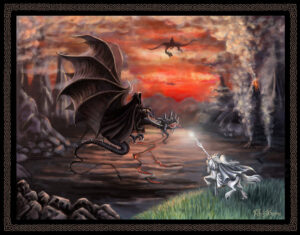
Anyone who has read the Sermon on the Mount knows that Christ is wise. He speaks with incredible authority “You have heard it said of old…But I say unto you…”8 Christ prophesies many things: His own death and Resurrection, the three-fold denial of St. Peter, the destruction of Jerusalem, and more. Christ is the prophet par excellence.
In The Lord of the Rings, Gandalf shoulders the monumental role of prophet. He predicts or foresees many events: the movements of the Enemy, the political intrigues of Rohan and Gondor, and even the impish shenanigans of hobbits. He carries a mysterious, timeless presence about him (read The Silmarillion if you want to know more about where he comes from). To put it bluntly, “he knows stuff.” He is wise, like Daniel. He is irascible, in the way I’ve often imagined the prophet Jeremiah to be irascible. He goes hither and yon bending and shaping events towards the good. And though “even the wise cannot see all ends,” Gandalf sees the big picture, more than any other member of the Fellowship. He is prophet material.
For the past few years, I have signed my emails with the following quote from Gandalf.
Other evils there are that may come…yet it is not our part to master all the tides of the world, but to do what is in us for the succour of those years wherein we are set, uprooting the evil in the fields that we know, so that those who live after may have clean earth to till. What weather they shall have is not ours to rule.9
In another unforgettable passage, a dialogue between Frodo and Gandalf underscores the lofty heights on which the latter operates.
‘But this is terrible!’ cried Frodo. ‘Far worse than the worst that I imagined from your hints and warnings. O Gandalf, best of friends, what am I to do? For now I am really afraid. What am I to do? What a pity that Bilbo did not stab that vile creature [Gollum] when he had a chance!’
‘Pity? It was Pity that stayed his hand. Pity, and Mercy: not to strike without need. And he has been well rewarded, Frodo. Be sure that he took so little hurt from the evil, and escaped in the end, because he began his ownership of the Ring so. With Pity.’
‘I am sorry,’ said Frodo. ‘But I am frightened; and I do not feel any pity for Gollum.’
‘You have not seen him,’ Gandalf broke in.
‘No, and I don’t want to,’ said Frodo. I can’t understand you. Do you mean to say that you, and the Elves, have let him live on after all those horrible deeds? Now at any rate he is as bad as an Orc, and just an enemy. He deserves death.’
‘Deserves it! I daresay he does. Many that live deserve death. And some that die deserve life. Can you give it to them? Then do not be too eager to deal out death in judgement. For even the very wise cannot see all ends. I have not much hope that Gollum can be cured before he dies, but there is a chance of it. And he is bound up with the fate of the Ring. My heart tells me that he has some part to play yet, for good or ill, before the end; and when that comes, the pity of Bilbo may rule the fate of many, yours not least.’10
Aragorn – Christ the King
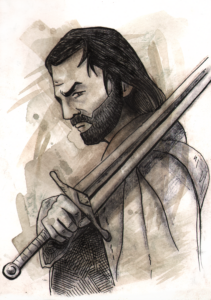
This connection requires the least convincing. Aragorn is a king. Christ is a King. Both kings begin their public lives in hidden obscurity. Neither is born with the proverbial silver spoon in the mouth. Both are repeatedly rejected and insulted by their inferiors, and both take it in stride. Both are kingly on the inside, and common on the outside. Both have moments of “transfiguration,” when the veil hiding their true glory is pulled aside for a moment. For Aragorn, these transfigurations happen multiple times. In certain key moments, he suddenly appears taller, noble, kingly, and terrible, in the best sense of the word. When the hobbits see this for the first time, they are awestruck, much as Peter, James, and John were blown away by the vision on Mt. Tabor.
Aragorn is a just king who abides by his own laws. After his coronation, he decrees that none of the “big folk” are to cross the borders of the Shire (the borders he once protected as a humble Ranger). When the Scouring of the Shire almost destroys the idyllic home of the halflings, Aragorn sees that if this fragile gem is to be preserved in Middle-Earth, it must be vigorously defended. And yet, he does not say goodbye to his hobbit-friends forever. This King of Gondor makes the long journey from his kingdom to the border of the Shire, and from Brandywine Bridge, he speaks with his friend Frodo of days gone by.11
My favorite moment in Aragorn’s reign is his restoration of the White Tree of Gondor. Long story short, the White Tree connects the line of Isiuldur, and the race of men, to the creation of Middle-Earth itself, beyond the mists of time (again, read The Silmarillion for more information). For all intents and purposes, the White Tree represents Tradition in Middle-Earth. And yet, the White Tree in Gondor is dead when Aragorn ascends the throne. Will Aragorn’s line die out? Are old prophecies useless? Is Aragorn a modern man who finds himself alone in a brave new world? No. With the help and guidance of Gandalf, Aragorn personally climbs the slopes of Mindolluin, above Minas Tirith, and there, the two of them find a living sapling of the White Tree. They bring that sapling back to the city, where it takes root, and grows healthy and strong. With the prophet Gandalf, Aragorn the king guides his realm by being firmly rooted in the received Tradition.
All that is gold does not glitter,
Not all those who wander are lost
The old that is strong does not wither,
Deep roots are not reached by the frost.From the ashes a fire shall be woken,
A light from the shadows shall spring;
Renewed shall be blade that was broken,
The crownless again shall be king.12
Conclusion
Why connect the three offices of Christ with the three heroes of The Lord of the Rings? For one, I hope this connection gives you a deeper appreciation for the greatest fantasy novel of all time. I hope it gives you a deeper appreciation for Tolkien himself, a giant among men, a devout Catholic, and a storyteller for the ages. But most of all, I hope this gives you a deeper knowledge and love of Jesus Christ, and His story, which is the greatest story ever told. Standing on the shoulders of J.R.R. Tolkien, I now understand a little more about Christ the High-Priest, Christ the Incarnate Wisdom, and Christ our gracious King.
If we shadows have offended
Think but this, and all is mended.
That you have but slumbered here,
While these visions did appear.13

Fr. Daniel Alloy, FSSP was ordained in 2020. He currently serves as parochial vicar at Regina Caeli Parish in Houston, TX.
- Cf. On Fairy-Stories, by Tolkien.
- Fun fact: these three offices are represented by linen (priesthood), wool (prophecy) and silk (kingship). These are the preferred materials for vestments, albs, and the like.
- Cf. John 18.
- Heb. 5:1.
- Heb. 5:2.
- Tolkien, J.R.R. The Lord of the Rings. New York: HarperCollins (1955). P. 1006.
- Ps. 68:21.
- Cf. Matthew 5.
- Tolkien, 861.
- Ibid., 58.
- Ibid., cf. Appendix B.
- Ibid., 167.
- A Midsummer Night’s Dream, Act V, Scene 1.
March 25, 2025

A Quick Look at Some Liturgical Privileges of the Kingdom of the Two Sicilies
by Fr. William Rock, FSSP

From A.D. 1816 to A.D. 1861, the island of Sicily and the southern part of the Italian peninsula comprised the Kingdom of the Two Sicilies. The origin of this uniquely and confusingly named kingdom, as it contained only one Sicily, goes back to A.D. 1130 when the Norman Roger II was recognized as the King of the Kingdom of Sicily, which included the island and the southern part of the peninsula. Through the twists and turns of history, the Kingdom of Sicily was divided into two, with both parts still being called the Kingdom of Sicily. So, there were, at this point, two Kingdoms of Sicily, one of which contained Sicily (with its capital at Palermo) and the other which was comprised of the peninsular lands (with its capital at Naples and which did not contain any Sicily). When the two Kingdoms of Sicily were reunited in A.D. 1816, instead of the united kingdom simply being called the Kingdom of Sicily, it was dubbed the Kingdom of the Two Sicilies. In any case, the Kingdom of the Two Sicilies had, like other kingdoms, certain liturgical privileges granted to it.1
The privileges which will be considered in this article are found in a Missal published in Naples, the capital of the Kingdom, in A.D. 1860 with additions approved by the Holy See. The first photograph above shows the inside title page of this Missal.
This second image shows two sets of orations, one set in each column, approved for use in the Kingdom of the Two Sicilies (Pro Regno Utriusque Siciliæ). These prayers would be added following the Collect (opening prayer), the Secret (prayer over the offerings), and Postcommunion (closing prayer) of the Mass being celebrated, according to the rubrics.
The prayers in the lefthand column are labeled as “for the King.” The note indicates that these were approved by Pope Pius IX (reigned from June 16, 1846 to February 7, 1878), who had a very strong relationship with the Kingdom of the Two Sicilies. The text of the prayer is the same as the general prayer for the King found in the Roman Missal (Pro Rege) with additional wording to include the Queen and the royal family as well (indicated in italics). A translation of the prayers are as follows:
Collect: We beseech Thee, Almighty God, that Thy servant N. our King, who by Thy mercy has taken up the government of the kingdom, and N. our Queen with the royal family, may gain from Thee the increase of all virtues, so that, being fittingly adorned thereby, they may be able both to avoid the monstrosities of sin and, as those enjoying favor, reach Thee Who art the Way, the Truth, and the Life. Through Our Lord…
Secret: We beseech Thee, O Lord, sanctify these offered gifts that they may become the Body and Blood of thine Only-begotten Son for us, and, by Thy bounty, in every way help our King, our Queen, and the royal family to obtain salvation of body and soul, and to carry out the office enjoined upon them. Through the same Our Lord…
Postcommunion: May this saving oblation, O Lord, protect Thy servant N. our King, N. our Queen, and the royal family, from all adversity, so that they may obtain both the tranquility of the Church’s peace and, after the course of this life, reach an eternal inheritance. Through Our Lord…
The righthand column contains prayers “for obtaining a happy delivery of the Queen,” to be said during her pregnancies. There are no corresponding prayers in the standard Roman Missal. The prayers read as follows:
Collect: Defend, we beseech Thee O Lord, Blessed Mary the ever Virgin interceding, from all adversity Thine handmaid N. our Queen: and grant, that her desired offspring, which Thou willed to be conceived in her womb, may be happily born and grow for the sake of the increase of religion and public safety. Through Our Lord…
Secret: Receive, we beseech Thee almighty God, the oblation of our devotion and through the virtue of this Sacrament, protect Thine handmaid N. our Queen and the fruit which she carries in her womb from all adversities. Through Our Lord…
Postcommunion: Favorably pour forth Thy blessing, O Lord, upon Thine handmaid N. our Queen: so that, together with her offspring, through the intercession of the Blessed Virgin Mary, she may be well in both mind and body; and, furnishing fitting service to Thee, she may always find the favors of Thy propitiation. Through Our Lord…
This last image shows the beginning of the Roman Canon. The part indicated by the green circle shows that the name of the king was added to the text so that it reads:
….Thy servant our Pope N., and our Bishop N., and our King N., and all orthodox believers and professors of the Catholic and Apostolic Faith.
While this addition mentioning the Christian sovereign in the Canon was the practice in the Middle Ages, the clause was removed in the Missal issued by Pope St. Pius V. Its use, by apostolic concession, was later granted to the Austro-Hungarian Empire (as the successor state of the Holy Roman Empire, although the verbiage was different in the Austrian and Hungarian territories),2 and also, the Kingdom of the Two Sicilies.
I hope, dear reader, that you enjoyed this quick look at some liturgical privileges of the Kingdom of the Two Sicilies and that it serves to show that, even when the Latin Mass was the norm in the Church, this did not mean that it was celebrated uniformly everywhere. There has always been a healthy liturgical diversity in the Church, liturgical diversity without ecclesiastical division and ecclesiastical unity without liturgical uniformity.
Fr. William Rock, FSSP was ordained in the fall of 2019 and is currently assigned to St. Stanislaus Parish in Nashua, NH.
In support of the causes of Blessed Maria Cristina, Queen, and Servant of God Francesco II, King
- Thanks are owed to Mr. Brendan Young, SMOCG, Executive Director of the American Delegation of the Sacred Military Constantinian Order of Saint George for providing the photographs of the Missal.
- Old Catholic Encyclopedia, s.v. “Canon of the Mass.”
March 14, 2025

In Memoriam: Fr. José María Salgado, FSSP (1933-2025)
OBITUARY
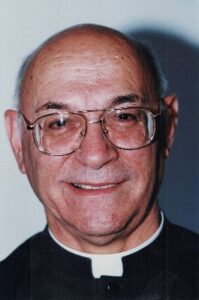
Father José María Salgado, FSSP passed away on March 8th, 2025. He was 92 years old.
Fr. Salgado was born on January 25th, 1933, the eleventh of thirteen children born to José Salgado and Maria Leyva Salgado. He was baptized at Holy Family Church in his native Tucson, Arizona.
Father Salgado served in the United States Army for two years after graduating from high school. He then attended a minor seminary but began a career as an electrical technician after graduating. He later received a Bachelor of Arts Degree in Languages from California State University of San Jose. He pursued his vocation again later in life, receiving a Master of Divinity Degree from Holy Apostles Seminary before being ordained a priest for the Diocese of Stockton, California in 1993.
Fr. Salgado loved the Traditional Latin Mass and applied to join the Priestly Fraternity of St. Peter in 1994. He was definitively incardinated into the Fraternity in 2001. Father served near Denver, Colorado for around ten years beginning in 1996. He was instrumental in developing the Fraternity apostolate there and put much effort into building a church for the Latin Mass Community in Littleton, Colorado. Father was skilled in carpentry and would personally work on building projects. He reluctantly left Colorado for his native Arizona in 2006. Father Salgado began offering Mass at St. Cecilia’s Catholic Church in Clarkdale, Arizona and was stationed there until he retired from public ministry in August of 2021.
Father’s beloved sister, Celia, assisted him at St. Cecilia’s as housekeeper and secretary. Fr. Salgado undertook renovation projects at St. Cecilia’s, doing much of the work himself. It was not uncommon to see the octogenarian priest up on the scaffolding in the church, hard at work. He would want to be remembered for his love of the Traditional Latin Mass and for the Church.
The exact arrangements for Father’s funeral are not yet finalized; however, a funeral Mass will be held at the Fraternity’s apostolate in Arizona.
Eternal rest grant unto him, O Lord, and let perpetual light shine upon him.
+ May his soul and all the souls of the faithful departed, rest in peace. Amen. +
March 10, 2025



